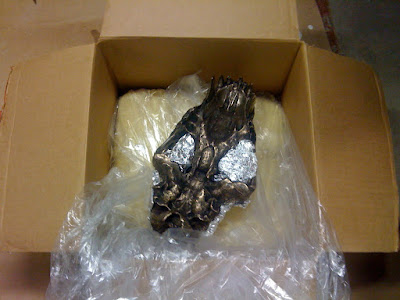Just a reminder that there is one week left until the early registration deadline for this year's Prep and Collections Symposium.
Registration forms can be downloaded from
www.fieldmuseum.org/prepsymposiumHere is the schedule, some AWESOME looking talks and workshops! What a lot of fun this will be!
Schedule of Events – Thursday, April 29th
9:00 AM Registration at West Entrance
Refreshments and light edibles available
Meet and greet, organize for tours
9:15 Collections and Laboratory Tours: participants placed upon arrival
Collection Resource Center
Fossil Mammal Collections, McDonald’s Fossil Preparation Laboratory,
Fossil Fish Collection, Herpetology Collection, Preparation Laboratories
12:00 PM Lunch served on Northwest Terrace (weather permitting)
In the case of inclement weather, lunch will be served in Lecture Hall 2
1:30 Roundtable Discussions
Air Abrasion Facilities & Techniques – J.P. Cavigelli and Anthony Maltese
Classroom B
Lab Safety, OSHA standards and MSDS – Jolynn Parchen
BioSync Conference Room
Laboratory Renovations and Design – Matt Brown
Ward Lecture Hall
Collecting Large Vertebrate Specimens – Mike Getty and Eric Lund
Lecture Hall 2
3:00 Break: refreshments available at west entrance
3:30 Roundtable Discussions
Molding, Casting and Reconstruction – Erin Fitzgerald and Tyler Keilor
Classroom B
Collections Management, Rehousing, and Organization - William Simpson
Fossil Mammal Collection
Volunteer Programs – Dennis Kinzig and Karen Nordquist
Classroom A
Professional Development – Greg Brown, Marilyn Fox, Matt Brown
Lecture Hall 2
5-9:00 Opening Reception
Rice Gallery, Main Floor (Center West), The Field Museum
Pizza, Beer and Beverages served
Schedule of Events – Friday Morning, April 30th
9:00 AM Registration at West Entrance
Refreshments and light edibles available
Platform Presentations: Ward Lecture Hall
9:15 Opening Remarks: Peter Makovicky, Chair, Geology Department
9:30 Simpson, William: 3D Surface Imaging of a Tyrannosaurus rex Skeleton Using Computed Tomography (CT) and Laser Scanning
9:45 Egberts, Sebastian: Use of Computed Tomography (CT) Data in Physical Preparation of Fossil Vertebrates
10:15 Carrió, Vicen: Protocols of Packaging and Moving Specimens: organization strategies for institutions
10:30 Van Beek, Constance: Preparation of Micro-features of Eocene Green River Formation Specimens: materials and methods
10:45 Break: refreshments available at west entrance
11:00 Wylie, Caitlin D.: Preparation and Society: fossil preparation techniques in the 19th century and today
11:15 Williams, Scott A.: The Permian Challenge: preparing small fossil tetrapods from Richard’s Spur, Oklahoma
11:30 Fry, Roger F. and Derek J. Main: Mapping and Excavating a Mid-Cretaceous Crocodile (Archosauria: Goniopholidae) at a Large Urban Dig Utilizing and All Volunteer Crew: the Arlington Archosaur Site, North Central Texas
11:45 Brown, Matthew: Renovation and Modernization of the University of Texas at Austin Fossil Preparation Laboratory
12:00 PM Lunch served on Northwest Terrace (weather permitting)
In the case of inclement weather, lunch will be served in Lecture Hall 2
1:00 PM McDonald, H. Gregory: A Brave New World: The Paleontological Resources Protection Act of 2009: collection management partnerships between federal agencies and non-federal repositories, a view from the National Park Service
1:30 Boonchai, Nareerat, Steve Manchester and Terry Lott: Methods for the Preparation and Anatomical Analysis of Eocene Leaf Cuticles from Puryear Claypit, Western Tennessee
1:45 Smith, Matthew E.: Preparation Methods for Fossil Invertebrates from Florida and the Caribbean Islands
2:15 Break: refreshments available at west entrance
2:30 Cavin, Jennifer L.: Cast Cutter Versus Hand Saw: an experiment in opening field jackets
2:45 Evander, Robert L.: Preventative Maintenance for Air Scribes
3:00 Nelson, Thomas L., Jennifer M. Grasso and Philip A. Gensler: Addressing a Critical Need Within the Collections at Hagerman Fossil Beds National Monument: refined and improved techniques and materials for the production of multi-size clam shell specimen cradles
3:30 Beiner, Gali Gali and Rivka Rabinovich: An Elephant Task: conservation methods of middle Pleistocene proboscidian remains from Revadim, Israel
3:45 Morrison, Ian:
4:00 Poster Session: Lecture Hall 2
Boonchai, Nareerat et.al.: Excavating Dinosaurs in Nakhon Ratchasima, Northeastern Thailand: how to deal with hard rock and fragmented bones
Fitzgerald, Vicki: Reproductive Health and Safety for Employees Working in Vertebrate Paleontology Laboratories
Maltese, Anthony: Enclosed Workspaces for Air Abrasion of Large Fossil Specimens
Potapova, Olga: Preservation Techniques and Documentation Procedures for Collections at the Mammoth Site of Hot Springs Inc., South Dakota
Val, Sandra et.al.: Preparation of Dinosaur Eggshells: new insights on traditional techniques
5:00 PM Meeting adjourned for the day
Schedule of Events – Saturday, May 1st
9:00 AM Workshops
Refreshments and light edibles available on the 3rd Floor
Archival Materials and Techniques for Fossil Preparation
Amy Davidson, Rm 3107 Fossil Preparation Lab.
Techniques for Acid Preparation
Jim Holstein, Rm 3112 Fossil Preparation Lab.
Creating Temporary Support Structures for Preparation
Debbie Wagner, Rm. 3226
Histology Techniques at The Field Museum
Akiko Shinya, Rm. 3013 Rock Sawing & Sample Prep. Lab.
12:00 PM Lunch served on Northwest Terrace (weather permitting)
In the case of inclement weather, lunch will be served in Lecture Hall 2
1:00 Workshops
Archival Materials and Techniques for Fossil Preparation
Amy Davidson, Rm 3107 Fossil Preparation Lab.
Techniques for Acid Preparation
Jim Holstein, Rm 3112 Fossil Preparation Lab.
Creating Temporary Support Structures for Preparation
Debbie Wagner, Rm. 3226
Histology Techniques at The Field Museum
Akiko Shinya, Rm. 3013 Rock Sawing & Sample Prep. Lab.
4:00 Workshops adjourn
6:00 PM Symposium Dinner Reception, offsite (see map & directions on p.6)
Museum Point Tower 3
Penthouse
233 East 13th St.
Contact Lisa Herzog for further information: lherzog@fieldmuseum.org
Direct: 312-665-7626





















